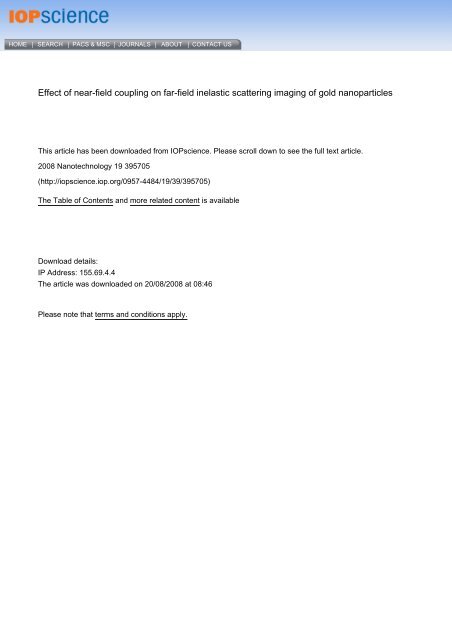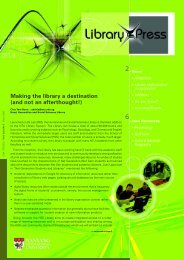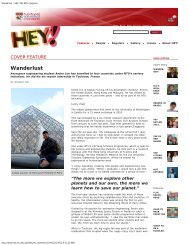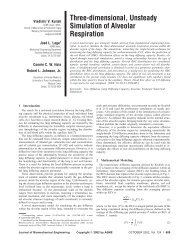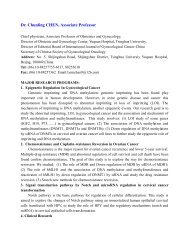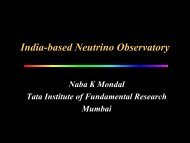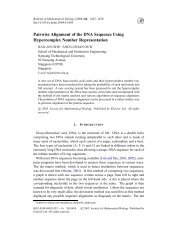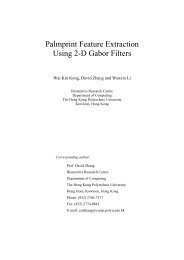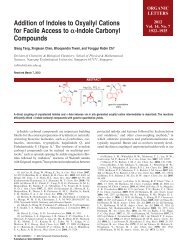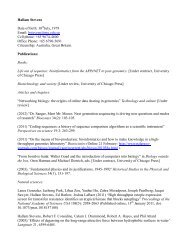Effect of near-field coupling on far-field inelastic scattering imaging ...
Effect of near-field coupling on far-field inelastic scattering imaging ...
Effect of near-field coupling on far-field inelastic scattering imaging ...
You also want an ePaper? Increase the reach of your titles
YUMPU automatically turns print PDFs into web optimized ePapers that Google loves.
HOME | SEARCH | PACS & MSC | JOURNALS | ABOUT | CONTACT US<br />
<str<strong>on</strong>g>Effect</str<strong>on</strong>g> <str<strong>on</strong>g>of</str<strong>on</strong>g> <str<strong>on</strong>g>near</str<strong>on</strong>g>-<str<strong>on</strong>g>field</str<strong>on</strong>g> <str<strong>on</strong>g>coupling</str<strong>on</strong>g> <strong>on</strong> <strong>far</strong>-<str<strong>on</strong>g>field</str<strong>on</strong>g> <strong>inelastic</strong> <strong>scattering</strong> <strong>imaging</strong> <str<strong>on</strong>g>of</str<strong>on</strong>g> gold nanoparticles<br />
This article has been downloaded from IOPscience. Please scroll down to see the full text article.<br />
2008 Nanotechnology 19 395705<br />
(http://iopscience.iop.org/0957-4484/19/39/395705)<br />
The Table <str<strong>on</strong>g>of</str<strong>on</strong>g> C<strong>on</strong>tents and more related c<strong>on</strong>tent is available<br />
Download details:<br />
IP Address: 155.69.4.4<br />
The article was downloaded <strong>on</strong> 20/08/2008 at 08:46<br />
Please note that terms and c<strong>on</strong>diti<strong>on</strong>s apply.
IOP PUBLISHING NANOTECHNOLOGY<br />
Nanotechnology 19 (2008) 395705 (5pp) doi:10.1088/0957-4484/19/39/395705<br />
<str<strong>on</strong>g>Effect</str<strong>on</strong>g> <str<strong>on</strong>g>of</str<strong>on</strong>g> <str<strong>on</strong>g>near</str<strong>on</strong>g>-<str<strong>on</strong>g>field</str<strong>on</strong>g> <str<strong>on</strong>g>coupling</str<strong>on</strong>g> <strong>on</strong> <strong>far</strong>-<str<strong>on</strong>g>field</str<strong>on</strong>g><br />
<strong>inelastic</strong> <strong>scattering</strong> <strong>imaging</strong> <str<strong>on</strong>g>of</str<strong>on</strong>g> gold<br />
nanoparticles<br />
YuMeng You, ChaoLing Du, Yun Ma, Johns<strong>on</strong> Kasim, Ting Yu and<br />
ZeXiang Shen 1<br />
Divisi<strong>on</strong> <str<strong>on</strong>g>of</str<strong>on</strong>g> Physics and Applied Physics, School <str<strong>on</strong>g>of</str<strong>on</strong>g> Physical and Mathematical Sciences,<br />
Nanyang Technological University, 1 Nanyang Walk, Block 5, Level 3, 637616, Singapore<br />
E-mail: zexiang@ntu.edu.sg<br />
Received 23 May 2008, in final form 10 July 2008<br />
Published 18 August 2008<br />
Online at stacks.iop.org/Nano/19/395705<br />
Abstract<br />
The optical <str<strong>on</strong>g>near</str<strong>on</strong>g>-<str<strong>on</strong>g>field</str<strong>on</strong>g> enhancement induced by <str<strong>on</strong>g>coupling</str<strong>on</strong>g> between noble nanoparticles and the<br />
substrate has been studied by a <strong>far</strong>-<str<strong>on</strong>g>field</str<strong>on</strong>g> <strong>imaging</strong> method. The l<strong>on</strong>gitudinal mode <str<strong>on</strong>g>of</str<strong>on</strong>g> the incident<br />
laser is revealed to c<strong>on</strong>tribute to the <str<strong>on</strong>g>coupling</str<strong>on</strong>g>. The <strong>far</strong>-<str<strong>on</strong>g>field</str<strong>on</strong>g> images <str<strong>on</strong>g>of</str<strong>on</strong>g> individual gold<br />
nanoparticles exhibit a peanut-shaped pattern; these were c<strong>on</strong>structed by the intensity <str<strong>on</strong>g>of</str<strong>on</strong>g><br />
<strong>inelastic</strong>ally scattered light. The <str<strong>on</strong>g>coupling</str<strong>on</strong>g> between gold nanoparticles and the silic<strong>on</strong> substrate<br />
leads to the patterned image. By tuning the separati<strong>on</strong> between the gold nanoparticles and<br />
substrate using SiO2 layers <str<strong>on</strong>g>of</str<strong>on</strong>g> different thickness, the <str<strong>on</strong>g>coupling</str<strong>on</strong>g> efficiency decreases with the<br />
thickness <str<strong>on</strong>g>of</str<strong>on</strong>g> the SiO2 layer.<br />
S Supplementary data are available from stacks.iop.org/Nano/19/395705<br />
(Some figures in this article are in colour <strong>on</strong>ly in the electr<strong>on</strong>ic versi<strong>on</strong>)<br />
1. Introducti<strong>on</strong><br />
Noble metal nanoparticles have attracted much attenti<strong>on</strong><br />
since the 19th century. In the last decade, investigati<strong>on</strong> <str<strong>on</strong>g>of</str<strong>on</strong>g><br />
surface plasm<strong>on</strong>s has revived intense interest in noble metal<br />
nanoparticles, which have found wide applicati<strong>on</strong> in surface<br />
enhanced Raman spectroscopy (SERS) [1, 2], plasm<strong>on</strong>ic<br />
crystals [3], biosensors [4] and nanolithography [5]. Surface<br />
plasm<strong>on</strong>s can be excited <strong>on</strong> noble metal nanoparticles and<br />
localized in very small volumes <str<strong>on</strong>g>of</str<strong>on</strong>g> metal nanoparticles. Such<br />
highly c<strong>on</strong>fined electric <str<strong>on</strong>g>field</str<strong>on</strong>g>s can enhance <strong>inelastic</strong> <strong>scattering</strong><br />
<str<strong>on</strong>g>of</str<strong>on</strong>g> light as Raman and photoluminescence (PL) [6, 7] signals.<br />
When a very sharp metal tip with a diameter around 10–100 nm<br />
is used, the spatial resoluti<strong>on</strong> and intensity <str<strong>on</strong>g>of</str<strong>on</strong>g> Raman <strong>imaging</strong><br />
can be impressively improved [8–11] due to the ‘lightning<br />
rod’ or ‘antenna’ effect [12]. Different aspects <str<strong>on</strong>g>of</str<strong>on</strong>g> localized<br />
surface plasm<strong>on</strong>s excited <strong>on</strong> noble metal nanoparticles have<br />
also been theoretically studied, such as particle sizes, shapes,<br />
assembly structures and their physical envir<strong>on</strong>ment [13–18].<br />
Since a substrate is normally necessary to support metal<br />
nanostructures in real experiments, <strong>on</strong>e needs to c<strong>on</strong>sider the<br />
1 Author to whom any corresp<strong>on</strong>dence should be addressed.<br />
interacti<strong>on</strong> between metal nanostructures and the supporting<br />
substrate—known as the substrate effect [19, 20] or ‘gap mode’<br />
effect [21]. Careful selecti<strong>on</strong> <str<strong>on</strong>g>of</str<strong>on</strong>g> substrates allows the local<br />
electromagnetic <str<strong>on</strong>g>field</str<strong>on</strong>g> to be greatly enhanced. Even more<br />
importantly, the lateral resoluti<strong>on</strong> can be improved to less<br />
than 1 nm even with a relatively large tip (20 nm), leading<br />
to molecular-scale spatial resoluti<strong>on</strong> [22, 23]. However, until<br />
now, most <str<strong>on</strong>g>of</str<strong>on</strong>g> the experiments c<strong>on</strong>cerning substrate effects <str<strong>on</strong>g>of</str<strong>on</strong>g><br />
individual nanostructures have been carried out in the <str<strong>on</strong>g>near</str<strong>on</strong>g><str<strong>on</strong>g>field</str<strong>on</strong>g>.<br />
Although such <str<strong>on</strong>g>near</str<strong>on</strong>g>-<str<strong>on</strong>g>field</str<strong>on</strong>g> techniques can provide a much<br />
better spatial resoluti<strong>on</strong>, the introduced sharp tip affects the<br />
local <str<strong>on</strong>g>field</str<strong>on</strong>g> distributi<strong>on</strong> <str<strong>on</strong>g>near</str<strong>on</strong>g> the metal nanoparticles. Here, we<br />
perform <strong>far</strong>-<str<strong>on</strong>g>field</str<strong>on</strong>g> <strong>inelastic</strong> <strong>scattering</strong> (IS) <strong>imaging</strong> to study the<br />
<str<strong>on</strong>g>near</str<strong>on</strong>g>-<str<strong>on</strong>g>field</str<strong>on</strong>g> ‘gap mode’ effect <str<strong>on</strong>g>of</str<strong>on</strong>g> metal nanoparticles <strong>on</strong> different<br />
thicknesses <str<strong>on</strong>g>of</str<strong>on</strong>g> SiO2 <strong>on</strong> silic<strong>on</strong> substrates.<br />
2. Experimental details<br />
In our experiments, <strong>imaging</strong> <str<strong>on</strong>g>of</str<strong>on</strong>g> <strong>inelastic</strong>ally scattered light<br />
(ISL) was carried out <strong>on</strong> gold nanoparticles in the <strong>far</strong>-<str<strong>on</strong>g>field</str<strong>on</strong>g><br />
by a WiTec CRM200 Raman system with a 100× objective<br />
lens (numerical aperture (NA) 0.95). The samples were<br />
0957-4484/08/395705+05$30.00 1<br />
© 2008 IOP Publishing Ltd Printed in the UK
Nanotechnology 19 (2008) 395705 YMYouet al<br />
scanned by a piezo-stage with step size smaller than 10 nm<br />
and the excitati<strong>on</strong> source was a 532 nm Nd:YAG laser. In<br />
the <strong>imaging</strong> process, the spectra were collected while scanning<br />
the sample with a step size <str<strong>on</strong>g>of</str<strong>on</strong>g> 50 nm. Then the computer<br />
analyzed the data and c<strong>on</strong>structed the images from the intensity<br />
<str<strong>on</strong>g>of</str<strong>on</strong>g> the ISL. Different thicknesses <str<strong>on</strong>g>of</str<strong>on</strong>g> SiO2 were grown <strong>on</strong><br />
silic<strong>on</strong> by annealing (for thicknesses less than 50 nm) and<br />
pulsed laser depositi<strong>on</strong> (for 6 nm and 100 nm thicknesses).<br />
The growth c<strong>on</strong>diti<strong>on</strong> <str<strong>on</strong>g>of</str<strong>on</strong>g> SiO2 can be found in supporting<br />
informati<strong>on</strong> (available at stacks.iop.org/Nano/19/395705). A<br />
diluted colloidal soluti<strong>on</strong> <str<strong>on</strong>g>of</str<strong>on</strong>g> gold nanoparticles (diameter 50 ±<br />
5 nm, Corpuscular Inc.) was dispersed <strong>on</strong> the SiO2/Si<br />
substrates and dried at room temperature. A scanning electr<strong>on</strong><br />
microscope (SEM) (Jeol JSM-6700F) was used to study the<br />
shape <str<strong>on</strong>g>of</str<strong>on</strong>g> the nanoparticles and locate the positi<strong>on</strong>s <str<strong>on</strong>g>of</str<strong>on</strong>g> the<br />
individual nanoparticles. The simulati<strong>on</strong> was performed by a<br />
finite element method (FEM) in COMSOL MULTIPHYSICS.<br />
3. Results and discussi<strong>on</strong><br />
Figure 1(a) shows a SEM image <str<strong>on</strong>g>of</str<strong>on</strong>g> gold nanoparticles <strong>on</strong> a<br />
silic<strong>on</strong> substrate with a SiO2 thickness around 6 nm. The<br />
inter-particle distance am<strong>on</strong>g the Au particles was large enough<br />
(more than 1 µm) for the <str<strong>on</strong>g>coupling</str<strong>on</strong>g> between nanoparticles to<br />
be neglected [24]. Figure 1(b) is an ISL image <str<strong>on</strong>g>of</str<strong>on</strong>g> the area<br />
indicated by the red square in figure 1(a), and the c<strong>on</strong>trast <str<strong>on</strong>g>of</str<strong>on</strong>g><br />
the image indicates the integrated intensity <str<strong>on</strong>g>of</str<strong>on</strong>g> ISL collected<br />
from gold nanoparticles in the range <str<strong>on</strong>g>of</str<strong>on</strong>g> 550–600 nm. It can be<br />
seen that the positi<strong>on</strong>s <str<strong>on</strong>g>of</str<strong>on</strong>g> gold nanoparticles in ISL <strong>imaging</strong><br />
corresp<strong>on</strong>d very well with those shown in the SEM image.<br />
The blue circles are a guide for the eyes <str<strong>on</strong>g>of</str<strong>on</strong>g> the positi<strong>on</strong>s <str<strong>on</strong>g>of</str<strong>on</strong>g><br />
gold nanoparticles. Several gold nanoparticles can be found in<br />
the SEM image, and we focus <strong>on</strong> the single nanoparticles, as<br />
indicated by the purple arrow in figure 1(a). The ISL <strong>imaging</strong><br />
Figure 1. (a) SEM image <str<strong>on</strong>g>of</str<strong>on</strong>g> gold nanoparticles <strong>on</strong> a silic<strong>on</strong> substrate<br />
with a 6 nm SiO2 ‘gap’. (b), (c) ISL images taken at the same<br />
locati<strong>on</strong> shown as (a), with incident laser <str<strong>on</strong>g>of</str<strong>on</strong>g> horiz<strong>on</strong>tal<br />
polarizati<strong>on</strong> (b) and vertical polarizati<strong>on</strong> (c). The purple arrows<br />
indicate a single gold nanoparticle. Blue circles in (b) and (c) are<br />
guides to the eyes to indicate the positi<strong>on</strong>s <str<strong>on</strong>g>of</str<strong>on</strong>g> gold nanoparticles.<br />
Green arrows show the polarizati<strong>on</strong> directi<strong>on</strong> <str<strong>on</strong>g>of</str<strong>on</strong>g> the incident laser.<br />
The white scale bar is 1 µm.<br />
Figure 2. (a) Schematic diagram showing the distributi<strong>on</strong> <str<strong>on</strong>g>of</str<strong>on</strong>g> the incident laser <str<strong>on</strong>g>field</str<strong>on</strong>g>. The normalized intensity <str<strong>on</strong>g>of</str<strong>on</strong>g> the calculated <str<strong>on</strong>g>field</str<strong>on</strong>g><br />
distributi<strong>on</strong> <str<strong>on</strong>g>of</str<strong>on</strong>g> the incident laser at the focal plane is plotted for the TM <str<strong>on</strong>g>field</str<strong>on</strong>g> (b) and for the LM <str<strong>on</strong>g>field</str<strong>on</strong>g> (c). (d) The calculated <str<strong>on</strong>g>field</str<strong>on</strong>g> distributi<strong>on</strong><br />
<str<strong>on</strong>g>of</str<strong>on</strong>g> a 50 nm diameter spherical gold nanoparticle. The nanoparticle is illuminated by a uniform incident <str<strong>on</strong>g>field</str<strong>on</strong>g> <str<strong>on</strong>g>of</str<strong>on</strong>g> 532 nm laser light with<br />
horiz<strong>on</strong>tal polarizati<strong>on</strong> (hence it is a TM <str<strong>on</strong>g>field</str<strong>on</strong>g> <strong>on</strong>ly). The cross-secti<strong>on</strong>al ISL intensity pr<str<strong>on</strong>g>of</str<strong>on</strong>g>iles under weak and str<strong>on</strong>g nanoparticle–substrate<br />
<str<strong>on</strong>g>coupling</str<strong>on</strong>g> c<strong>on</strong>diti<strong>on</strong>s are shown in (e) and (f), respectively. The intensity <str<strong>on</strong>g>of</str<strong>on</strong>g> ISL excited by the LM <str<strong>on</strong>g>field</str<strong>on</strong>g> is str<strong>on</strong>ger in (f) because <str<strong>on</strong>g>of</str<strong>on</strong>g> the str<strong>on</strong>g<br />
<str<strong>on</strong>g>coupling</str<strong>on</strong>g>. Hence the splitting looks more obvious.<br />
2
Nanotechnology 19 (2008) 395705 YMYouet al<br />
Figure 3. (a)–(f) ISL <strong>imaging</strong> results from individual gold nanoparticles <strong>on</strong> substrates with different SiO2 thicknesses. The <strong>imaging</strong> area<br />
for (a)–(f) is 2 µm × 2 µm and the scale bar in part (a) is 1 µm. In (a)–(f) the directi<strong>on</strong> <str<strong>on</strong>g>of</str<strong>on</strong>g> laser polarizati<strong>on</strong> is always horiz<strong>on</strong>tal. (g), (h)<br />
Comparis<strong>on</strong> <str<strong>on</strong>g>of</str<strong>on</strong>g> cross-secti<strong>on</strong>al ISL intensity pr<str<strong>on</strong>g>of</str<strong>on</strong>g>ile (g) al<strong>on</strong>g the directi<strong>on</strong> <str<strong>on</strong>g>of</str<strong>on</strong>g> laser polarizati<strong>on</strong> and (h) perpendicular to the directi<strong>on</strong> <str<strong>on</strong>g>of</str<strong>on</strong>g> laser<br />
polarizati<strong>on</strong>.<br />
results are shown in figures 1(b) and (c). The ISL images<br />
show peanut-shaped patterns with two maximum intensity<br />
spots located at the sides <str<strong>on</strong>g>of</str<strong>on</strong>g> the nanoparticle, and the distance<br />
between the two spots is about 350 nm. This ISL intensity<br />
distributi<strong>on</strong> shows str<strong>on</strong>g polarizati<strong>on</strong> dependence. By rotating<br />
the polarizati<strong>on</strong> <str<strong>on</strong>g>of</str<strong>on</strong>g> incident laser, the distributi<strong>on</strong> pattern <str<strong>on</strong>g>of</str<strong>on</strong>g> ISL<br />
intensity also rotates corresp<strong>on</strong>dingly, as shown in figure 1(c).<br />
Normally, at the focus point the incident laser can be<br />
approximated as a plane wave with Gaussian distributi<strong>on</strong>,<br />
called the transverse mode (TM) <str<strong>on</strong>g>of</str<strong>on</strong>g> the laser. The polarizati<strong>on</strong><br />
directi<strong>on</strong> <str<strong>on</strong>g>of</str<strong>on</strong>g> the TM <str<strong>on</strong>g>field</str<strong>on</strong>g> is parallel to the sample surface<br />
and perpendicular to the directi<strong>on</strong> <str<strong>on</strong>g>of</str<strong>on</strong>g> propagati<strong>on</strong> <str<strong>on</strong>g>of</str<strong>on</strong>g> the<br />
laser. When excited by such a TM <str<strong>on</strong>g>field</str<strong>on</strong>g>, the most intense<br />
<str<strong>on</strong>g>field</str<strong>on</strong>g> is found at the two poles <str<strong>on</strong>g>of</str<strong>on</strong>g> the nanoparticle al<strong>on</strong>g<br />
the polarizati<strong>on</strong> directi<strong>on</strong> <str<strong>on</strong>g>of</str<strong>on</strong>g> the exciting electric <str<strong>on</strong>g>field</str<strong>on</strong>g> [25],<br />
3<br />
as illustrated in figure 2(d). However, due to our <strong>far</strong>-<str<strong>on</strong>g>field</str<strong>on</strong>g><br />
experimental setup, these two intense spots <strong>on</strong> the particle<br />
surface are too close (50 nm, equal to the diameter <str<strong>on</strong>g>of</str<strong>on</strong>g><br />
nanoparticle) to be resolved. Hence the peanut-shaped ISL<br />
pattern <str<strong>on</strong>g>of</str<strong>on</strong>g> a single gold nanoparticle in figure 1(b) is not<br />
caused by the TM <str<strong>on</strong>g>field</str<strong>on</strong>g> <str<strong>on</strong>g>of</str<strong>on</strong>g> the incident laser. It is well known<br />
that by using a high NA objective lens, a str<strong>on</strong>g l<strong>on</strong>gitudinal<br />
mode (LM) <str<strong>on</strong>g>field</str<strong>on</strong>g> can be created <str<strong>on</strong>g>near</str<strong>on</strong>g> the focal point [26],<br />
as illustrated by figure 2(a). Figures 2(b) and (c) show the<br />
calculated spatial intensity distributi<strong>on</strong> <str<strong>on</strong>g>of</str<strong>on</strong>g> the TM and LM <str<strong>on</strong>g>field</str<strong>on</strong>g><br />
in the focal plane <str<strong>on</strong>g>of</str<strong>on</strong>g> a tightly focused Gaussian beam with a<br />
NA <str<strong>on</strong>g>of</str<strong>on</strong>g> 0.95. In figure 2(c), two bright lobes <str<strong>on</strong>g>of</str<strong>on</strong>g> equal intensity<br />
and oriented al<strong>on</strong>g the directi<strong>on</strong> <str<strong>on</strong>g>of</str<strong>on</strong>g> polarizati<strong>on</strong> <str<strong>on</strong>g>of</str<strong>on</strong>g> the beam<br />
can be seen. The directi<strong>on</strong> <str<strong>on</strong>g>of</str<strong>on</strong>g> such a LM <str<strong>on</strong>g>field</str<strong>on</strong>g> is parallel to the<br />
directi<strong>on</strong> <str<strong>on</strong>g>of</str<strong>on</strong>g> propagati<strong>on</strong> <str<strong>on</strong>g>of</str<strong>on</strong>g> the beam and localized at the sides
Nanotechnology 19 (2008) 395705 YMYouet al<br />
Figure 4. (a) Distance between the two ISL peaks induced by the LM <str<strong>on</strong>g>field</str<strong>on</strong>g>. (b) Relative intensity ILM/ITM <str<strong>on</strong>g>of</str<strong>on</strong>g> PL induced by the LM <str<strong>on</strong>g>field</str<strong>on</strong>g> as a<br />
functi<strong>on</strong> <str<strong>on</strong>g>of</str<strong>on</strong>g> nanoparticle–substrate separati<strong>on</strong>.<br />
<str<strong>on</strong>g>of</str<strong>on</strong>g> the focal point. The LM <str<strong>on</strong>g>field</str<strong>on</strong>g> spatial distributi<strong>on</strong> pattern<br />
in figure 2(c) matches well with our experimental results, not<br />
<strong>on</strong>ly in the shape and polarizati<strong>on</strong> dependence but also the<br />
separati<strong>on</strong> between the two lobes. We therefore c<strong>on</strong>clude that<br />
the peanut-shaped pattern in our ISL <strong>imaging</strong> is due to the<br />
presence <str<strong>on</strong>g>of</str<strong>on</strong>g> the LM <str<strong>on</strong>g>field</str<strong>on</strong>g> <str<strong>on</strong>g>of</str<strong>on</strong>g> our tightly focused laser beam.<br />
When a focused laser spot was scanned across gold<br />
nanoparticles, ISL was excited by both the TM <str<strong>on</strong>g>field</str<strong>on</strong>g> and the<br />
LM <str<strong>on</strong>g>field</str<strong>on</strong>g>. The spatial distributi<strong>on</strong> <str<strong>on</strong>g>of</str<strong>on</strong>g> ISL intensity should<br />
reflect the intensity distributi<strong>on</strong> <str<strong>on</strong>g>of</str<strong>on</strong>g> the laser spot shown in<br />
figure 2(a). Thus both TM and LM comp<strong>on</strong>ents c<strong>on</strong>tribute to<br />
the cross-secti<strong>on</strong>al intensity pr<str<strong>on</strong>g>of</str<strong>on</strong>g>ile <str<strong>on</strong>g>of</str<strong>on</strong>g> gold nanoparticle ISL, as<br />
showninfigures2(e) and (f). The middle peak is due to the TM<br />
comp<strong>on</strong>ent, located at the exact positi<strong>on</strong> <str<strong>on</strong>g>of</str<strong>on</strong>g> nanoparticle, and<br />
the other two peaks are excited by the LM comp<strong>on</strong>ent, located<br />
at the sides <str<strong>on</strong>g>of</str<strong>on</strong>g> the nanoparticle oriented al<strong>on</strong>g the directi<strong>on</strong> <str<strong>on</strong>g>of</str<strong>on</strong>g><br />
polarizati<strong>on</strong> <str<strong>on</strong>g>of</str<strong>on</strong>g> the incident light. Normally, the LM <str<strong>on</strong>g>field</str<strong>on</strong>g> is<br />
weaker than the TM <str<strong>on</strong>g>field</str<strong>on</strong>g>, leading to an intensity distributi<strong>on</strong><br />
pr<str<strong>on</strong>g>of</str<strong>on</strong>g>ile seen in figure 2(e). The two peaks at the sides are not<br />
very obvious compared to the middle peak, so that the weak<br />
LM <str<strong>on</strong>g>field</str<strong>on</strong>g> induced ISL peaks merged with those <str<strong>on</strong>g>of</str<strong>on</strong>g> the TM<br />
<str<strong>on</strong>g>field</str<strong>on</strong>g>. But in our case the intensity <str<strong>on</strong>g>of</str<strong>on</strong>g> the LM <str<strong>on</strong>g>field</str<strong>on</strong>g> induced<br />
peaks is much higher than those <str<strong>on</strong>g>of</str<strong>on</strong>g> the TM <str<strong>on</strong>g>field</str<strong>on</strong>g>, causing the<br />
splitting pattern illustrated in figure 2(f). We attribute the ISL<br />
enhancement induced by the LM <str<strong>on</strong>g>field</str<strong>on</strong>g> to the str<strong>on</strong>g <str<strong>on</strong>g>coupling</str<strong>on</strong>g><br />
between the silic<strong>on</strong> substrate and the gold nanoparticle, in<br />
agreement with theoretical studies [27–29]. In the ‘gap mode’<br />
model, a gold nanoparticle with a diameter <str<strong>on</strong>g>of</str<strong>on</strong>g> about 50 nm<br />
can be approximated to be an electric dipole polarized by the<br />
incident laser. When the distance between gold nanoparticles<br />
and the silic<strong>on</strong> substrate is small enough, the dipole <str<strong>on</strong>g>of</str<strong>on</strong>g> the gold<br />
nanoparticle and its imaginary dipole inside the substrate can<br />
couple and cause steep enhancement <str<strong>on</strong>g>of</str<strong>on</strong>g> local electric <str<strong>on</strong>g>field</str<strong>on</strong>g>, and<br />
generate a much str<strong>on</strong>ger ISL from gold nanoparticles [30].<br />
To further study the substrate effect, we spread the gold<br />
nanoparticles <strong>on</strong> different thicknesses <str<strong>on</strong>g>of</str<strong>on</strong>g> SiO2 <strong>on</strong> silic<strong>on</strong><br />
substrates and performed similar ISL <strong>imaging</strong> measurements.<br />
The different SiO2 thickness in these samples serves as a<br />
medium for adjusting the distance between gold nanoparticles<br />
4<br />
and their imaginary dipole. The results are shown in figure 3.<br />
Figures 3(a)–(f) are the ISL images <str<strong>on</strong>g>of</str<strong>on</strong>g> samples with different<br />
SiO2 thicknesses <str<strong>on</strong>g>of</str<strong>on</strong>g> about 6 nm, 13 nm, 15 nm, 18 nm,<br />
27 nm and 100 nm, respectively. The blue circles are guides<br />
to locate the positi<strong>on</strong>s <str<strong>on</strong>g>of</str<strong>on</strong>g> the gold nanoparticles. When<br />
the gold nanoparticles are immobilized <strong>on</strong> the substrate with<br />
a 100 nm SiO2 separati<strong>on</strong>, the most intense point <str<strong>on</strong>g>of</str<strong>on</strong>g> the<br />
ISL pattern (figure 3(f)) is sitting <strong>on</strong> the exact positi<strong>on</strong> <str<strong>on</strong>g>of</str<strong>on</strong>g><br />
the gold nanoparticles and appears as an elliptical shape.<br />
The intensity pattern splits as the SiO2 separati<strong>on</strong> decreases.<br />
Finally, the ISL intensity distributi<strong>on</strong> pattern becomes two<br />
bright lobes at the sides <str<strong>on</strong>g>of</str<strong>on</strong>g> the gold nanoparticles, as shown<br />
in figure 3(a). Figure 3(g) compares the cross-secti<strong>on</strong>al<br />
ISL intensity pr<str<strong>on</strong>g>of</str<strong>on</strong>g>iles <str<strong>on</strong>g>of</str<strong>on</strong>g> single gold nanoparticles al<strong>on</strong>g the<br />
directi<strong>on</strong> <str<strong>on</strong>g>of</str<strong>on</strong>g> laser polarizati<strong>on</strong> as indicated by the green solid<br />
line in figure 3(b). From those images we can c<strong>on</strong>clude<br />
that while decreasing the separati<strong>on</strong> between nanoparticles<br />
and silic<strong>on</strong> the <str<strong>on</strong>g>coupling</str<strong>on</strong>g> efficiency between them becomes<br />
promoted as well. Larger <str<strong>on</strong>g>coupling</str<strong>on</strong>g> will excite a str<strong>on</strong>ger<br />
ISL from gold nanoparticles, which makes the splitting more<br />
obvious. The cross-secti<strong>on</strong>al ISL intensity pr<str<strong>on</strong>g>of</str<strong>on</strong>g>iles <str<strong>on</strong>g>of</str<strong>on</strong>g> the<br />
same nanoparticles taken perpendicular to the directi<strong>on</strong> <str<strong>on</strong>g>of</str<strong>on</strong>g> laser<br />
polarizati<strong>on</strong> are shown in figure 3(h). No obvious change is<br />
found in figure 3(h) for different SiO2 thicknesses, because<br />
the laser LM <str<strong>on</strong>g>field</str<strong>on</strong>g> <strong>on</strong>ly exists al<strong>on</strong>g the directi<strong>on</strong> <str<strong>on</strong>g>of</str<strong>on</strong>g> laser<br />
polarizati<strong>on</strong>.<br />
To quantify the <str<strong>on</strong>g>coupling</str<strong>on</strong>g> relati<strong>on</strong>ship, the cross-secti<strong>on</strong>al<br />
ISL intensity pr<str<strong>on</strong>g>of</str<strong>on</strong>g>iles <str<strong>on</strong>g>of</str<strong>on</strong>g> different samples were then fitted<br />
by three peaks (two from the LM induced comp<strong>on</strong>ent and<br />
<strong>on</strong>e from the TM induced comp<strong>on</strong>ent), and the results are<br />
showninfigure4. Figure 4(a) plots the separati<strong>on</strong> between<br />
two ISL peaks excited by the TM <str<strong>on</strong>g>field</str<strong>on</strong>g> as a functi<strong>on</strong> <str<strong>on</strong>g>of</str<strong>on</strong>g> the<br />
SiO2 ‘gap’ thickness. The separati<strong>on</strong> remains approximately<br />
c<strong>on</strong>stant (between 300 and 400 nm). Firstly, this is to be<br />
expected as such separati<strong>on</strong> is caused by the n<strong>on</strong>-uniformity <str<strong>on</strong>g>of</str<strong>on</strong>g><br />
incident laser at the focal plane but not the thickness <str<strong>on</strong>g>of</str<strong>on</strong>g> SiO2.<br />
Sec<strong>on</strong>dly, the separati<strong>on</strong> is equal to the distance between the<br />
two maximum incident LM <str<strong>on</strong>g>field</str<strong>on</strong>g>s at the focal plane, which is<br />
a c<strong>on</strong>stant in our experiment setup. On the other hand, the
Nanotechnology 19 (2008) 395705 YMYouet al<br />
intensity <str<strong>on</strong>g>of</str<strong>on</strong>g> LM induced ISL is very sensitive to the distance<br />
between the nanoparticle and the silic<strong>on</strong> surface, because such<br />
<str<strong>on</strong>g>coupling</str<strong>on</strong>g> is characteristic <str<strong>on</strong>g>of</str<strong>on</strong>g> the <str<strong>on</strong>g>near</str<strong>on</strong>g>-<str<strong>on</strong>g>field</str<strong>on</strong>g>. Figure 4(b) plots<br />
the relative ISL intensity (ILM/ITM) as a functi<strong>on</strong> <str<strong>on</strong>g>of</str<strong>on</strong>g> gold<br />
nanoparticles–silic<strong>on</strong> substrate separati<strong>on</strong>. The data points<br />
fit well with simulati<strong>on</strong> results. From the data we can see<br />
that the <str<strong>on</strong>g>coupling</str<strong>on</strong>g> <str<strong>on</strong>g>of</str<strong>on</strong>g> gold nanoparticles and silic<strong>on</strong> becomes<br />
less effective when the separati<strong>on</strong> is greater than 20 nm,<br />
which agrees with the evanescent behavior <str<strong>on</strong>g>of</str<strong>on</strong>g> this <str<strong>on</strong>g>near</str<strong>on</strong>g>-<str<strong>on</strong>g>field</str<strong>on</strong>g><br />
phenomen<strong>on</strong>. The experimental curve shows a good similarity<br />
to the literature where an AFM tip with a gold coating or gold<br />
nanoparticles is used [30, 31].<br />
4. C<strong>on</strong>clusi<strong>on</strong><br />
In this paper we report the observati<strong>on</strong> <str<strong>on</strong>g>of</str<strong>on</strong>g> <str<strong>on</strong>g>near</str<strong>on</strong>g>-<str<strong>on</strong>g>field</str<strong>on</strong>g> <str<strong>on</strong>g>coupling</str<strong>on</strong>g><br />
between gold nanoparticles and a silic<strong>on</strong> substrate by <strong>far</strong>-<str<strong>on</strong>g>field</str<strong>on</strong>g><br />
<strong>imaging</strong>. The <str<strong>on</strong>g>coupling</str<strong>on</strong>g>-induced peanut-shaped pattern <str<strong>on</strong>g>of</str<strong>on</strong>g> the<br />
ISL intensity distributi<strong>on</strong> is also studied. Our results show that<br />
the <str<strong>on</strong>g>coupling</str<strong>on</strong>g> between gold nanoparticles and silic<strong>on</strong> substrate<br />
can enhance the ISL. By introducing different thicknesses <str<strong>on</strong>g>of</str<strong>on</strong>g><br />
SiO2 layers between a silic<strong>on</strong> substrate and gold nanoparticles,<br />
the enhancement can be c<strong>on</strong>trollably varied. Such an effect<br />
can also be used to carry out SERS by attaching the molecule<br />
between gold nanoparticles and a substrate, and may also apply<br />
to nanolithographic technology. Further SERS experiments are<br />
under way.<br />
References<br />
[1] Dornhaus R, Benner R E, Chang R K and Chabay I 1980<br />
Surface-plasm<strong>on</strong> c<strong>on</strong>tributi<strong>on</strong> to Sers Surf. Sci.<br />
101 367–73<br />
[2] GarciaVidal F J and Pendry J B 1996 Collective theory for<br />
surface enhanced Raman <strong>scattering</strong> Phys. Rev. Lett.<br />
77 1163–6<br />
[3] Grigorenko A N, Geim A K, Glees<strong>on</strong> H F, Zhang Y,<br />
Firsov A A, Khrushchev I Y and Petrovic J 2005<br />
Nan<str<strong>on</strong>g>of</str<strong>on</strong>g>abricated media with negative permeability at visible<br />
frequencies Nature 438 335–8<br />
[4] Haes A J and Van Duyne R P 2002 A nanoscale optical<br />
biosensor: sensitivity and selectivity <str<strong>on</strong>g>of</str<strong>on</strong>g> an approach based<br />
<strong>on</strong> the localized surface plasm<strong>on</strong> res<strong>on</strong>ance spectroscopy <str<strong>on</strong>g>of</str<strong>on</strong>g><br />
triangular silver nanoparticles J. Am. Chem. Soc.<br />
124 10596–604<br />
[5] Heltzel A, Theppakuttai S, Chen S C and Howell J R 2008<br />
Surface plasm<strong>on</strong>-based nanopatterning assisted by gold<br />
nanospheres Nanotechnology 19 025305<br />
[6] Okamoto K, Niki I, Shvartser A, Narukawa Y, Mukai T and<br />
Scherer A 2004 Surface-plasm<strong>on</strong>-enhanced light emitters<br />
based <strong>on</strong> InGaN quantum wells Nat. Mater. 3 601–5<br />
[7] Kuhn S, Hakans<strong>on</strong> U, Rogobete L and Sandoghdar V 2006<br />
Enhancement <str<strong>on</strong>g>of</str<strong>on</strong>g> single-molecule fluorescence using a gold<br />
nanoparticle as an optical nanoantenna Phys. Rev. Lett.<br />
97 017402<br />
[8] Hayazawa N, Inouye Y, Sekkat Z and Kawata S 2001<br />
Near-<str<strong>on</strong>g>field</str<strong>on</strong>g> Raman <strong>scattering</strong> enhanced by a metallized tip<br />
Chem. Phys. Lett. 335 369–74<br />
[9] Anders<strong>on</strong> M S 2000 Locally enhanced Raman spectroscopy<br />
with an atomic force microscope Appl. Phys. Lett.<br />
76 3130–2<br />
[10] Stockle R M, Suh Y D, Deckert V and Zenobi R 2000<br />
Nanoscale chemical analysis by tip-enhanced Raman<br />
spectroscopy Chem. Phys. Lett. 318 131–6<br />
5<br />
[11] Bar G, Rubin S, Cutts R W, Taylor T N and Zawodzinski T A<br />
1996 Dendrimer-modified silic<strong>on</strong> oxide surfaces as<br />
platforms for the depositi<strong>on</strong> <str<strong>on</strong>g>of</str<strong>on</strong>g> gold and silver colloid<br />
m<strong>on</strong>olayers: preparati<strong>on</strong> method, characterizati<strong>on</strong>, and<br />
correlati<strong>on</strong> between microstructure and optical properties<br />
Langmuir 12 1172–9<br />
[12] Patane S, Gucciardi P G, Labardi M and Allegrini M 2004<br />
Apertureless <str<strong>on</strong>g>near</str<strong>on</strong>g>-<str<strong>on</strong>g>field</str<strong>on</strong>g> optical microscopy Rev. Nuovo<br />
Cimento 27 1–46<br />
[13] Jain P K, Lee K S, El-Sayed I H and El-Sayed M A 2006<br />
Calculated absorpti<strong>on</strong> and <strong>scattering</strong> properties <str<strong>on</strong>g>of</str<strong>on</strong>g> gold<br />
nanoparticles <str<strong>on</strong>g>of</str<strong>on</strong>g> different size, shape, and compositi<strong>on</strong>:<br />
applicati<strong>on</strong>s in biological <strong>imaging</strong> and biomedicine<br />
J. Phys. Chem. B 110 7238–48<br />
[14] Govorov A O, Bryant G W, Zhang W, Skeini T, Lee J,<br />
Kotov N A, Slocik J M and Naik R R 2006 Excit<strong>on</strong>–plasm<strong>on</strong><br />
interacti<strong>on</strong> and hybrid excit<strong>on</strong>s in semic<strong>on</strong>ductor–metal<br />
nanoparticle assemblies Nano Lett. 6 984–94<br />
[15] Schatz G C 2001 Electrodynamics <str<strong>on</strong>g>of</str<strong>on</strong>g> n<strong>on</strong>spherical noble metal<br />
nanoparticles and nanoparticle aggregates J. Mol. Struct.<br />
Theochem. 573 73–80<br />
[16] Jensen T, Kelly L, Lazarides A and Schatz G C 1999<br />
Electrodynamics <str<strong>on</strong>g>of</str<strong>on</strong>g> noble metal nanoparticles and<br />
nanoparticle clusters J. Clust. Sci. 10 295–317<br />
[17] Mock J J, Barbic M, Smith D R, Schultz D A and<br />
Schultz S 2002 Shape effects in plasm<strong>on</strong> res<strong>on</strong>ance <str<strong>on</strong>g>of</str<strong>on</strong>g><br />
individual colloidal silver nanoparticles J. Chem. Phys.<br />
116 6755–9<br />
[18] Noguez C 2007 Surface plasm<strong>on</strong>s <strong>on</strong> metal nanoparticles: the<br />
influence <str<strong>on</strong>g>of</str<strong>on</strong>g> shape and physical envir<strong>on</strong>ment J. Phys. Chem.<br />
C 111 3806–19<br />
[19] Wind M M, Bobbert P A, Vlieger J and Bedeaux D 1987<br />
The polarizability <str<strong>on</strong>g>of</str<strong>on</strong>g> a truncated sphere <strong>on</strong> a substrate-2<br />
Physica A 143 164–82<br />
[20] Wind M M, Vlieger J and Bedeaux D 1987 The polarizability <str<strong>on</strong>g>of</str<strong>on</strong>g><br />
a truncated sphere <strong>on</strong> a substrate—I Physica A 141 33–57<br />
[21] Hayashi S 2001 Near-Field Optics and Surface Plasm<strong>on</strong><br />
Polarit<strong>on</strong>s (Berlin: Springer) pp 71–95<br />
[22] Downes A, Salter D and Elfick A 2006 Finite element<br />
simulati<strong>on</strong>s <str<strong>on</strong>g>of</str<strong>on</strong>g> tip-enhanced Raman and fluorescence<br />
spectroscopy J. Phys. Chem. B 110 6692–8<br />
[23] Notingher I and Elfick A 2005 <str<strong>on</strong>g>Effect</str<strong>on</strong>g> <str<strong>on</strong>g>of</str<strong>on</strong>g> sample and substrate<br />
electric properties <strong>on</strong> the electric <str<strong>on</strong>g>field</str<strong>on</strong>g> enhancement at the<br />
apex <str<strong>on</strong>g>of</str<strong>on</strong>g> SPM nanotips J. Phys. Chem. B 109 15699–706<br />
[24] Su K H, Wei Q H, Zhang X, Mock J J, Smith D R and<br />
Schultz S 2003 Interparticle <str<strong>on</strong>g>coupling</str<strong>on</strong>g> effects <strong>on</strong> plasm<strong>on</strong><br />
res<strong>on</strong>ances <str<strong>on</strong>g>of</str<strong>on</strong>g> nanogold particles Nano Lett. 3 1087–90<br />
[25] Okamoto H and Imura K 2006 Near-<str<strong>on</strong>g>field</str<strong>on</strong>g> <strong>imaging</strong> <str<strong>on</strong>g>of</str<strong>on</strong>g> optical<br />
<str<strong>on</strong>g>field</str<strong>on</strong>g> and plasm<strong>on</strong> wavefuncti<strong>on</strong>s in metal nanoparticles<br />
J. Mater. Chem. 16 3920–8<br />
[26] Bouhelier A, Beversluis M R and Novotny L 2003 Near-<str<strong>on</strong>g>field</str<strong>on</strong>g><br />
<strong>scattering</strong> <str<strong>on</strong>g>of</str<strong>on</strong>g> l<strong>on</strong>gitudinal <str<strong>on</strong>g>field</str<strong>on</strong>g>s Appl. Phys. Lett. 82 4596–8<br />
[27] Novotny L, Sanchez E J and Xie X S 1998 Near-<str<strong>on</strong>g>field</str<strong>on</strong>g> optical<br />
<strong>imaging</strong> using metal tips illuminated by higher-order<br />
Hermite–Gaussian beams Ultramicroscopy 71 21–9<br />
[28] Gozhenko V V, Grechko L G and Whites K W 2003<br />
Electrodynamics <str<strong>on</strong>g>of</str<strong>on</strong>g> spatial clusters <str<strong>on</strong>g>of</str<strong>on</strong>g> spheres: substrate<br />
effects Phys. Rev. B 68 125422<br />
[29] Lazzari R, Sim<strong>on</strong>sen I, Bedeaux D, Vlieger J and Jupille J 2001<br />
Polarizability <str<strong>on</strong>g>of</str<strong>on</strong>g> truncated spheroidal particles supported by<br />
a substrate: model and applicati<strong>on</strong>s EurPhys. J. B<br />
24 267–84<br />
[30] Knoll B and Keilmann F 2000 Enhanced dielectric c<strong>on</strong>trast in<br />
<strong>scattering</strong>-type scanning <str<strong>on</strong>g>near</str<strong>on</strong>g>-<str<strong>on</strong>g>field</str<strong>on</strong>g> optical microscopy<br />
Opt. Commun. 182 321–8<br />
[31] Kim Z H and Le<strong>on</strong>e S R 2006 High-resoluti<strong>on</strong> apertureless<br />
<str<strong>on</strong>g>near</str<strong>on</strong>g>-<str<strong>on</strong>g>field</str<strong>on</strong>g> optical <strong>imaging</strong> using gold nanosphere probes<br />
J. Phys. Chem. B 110 19804–9


